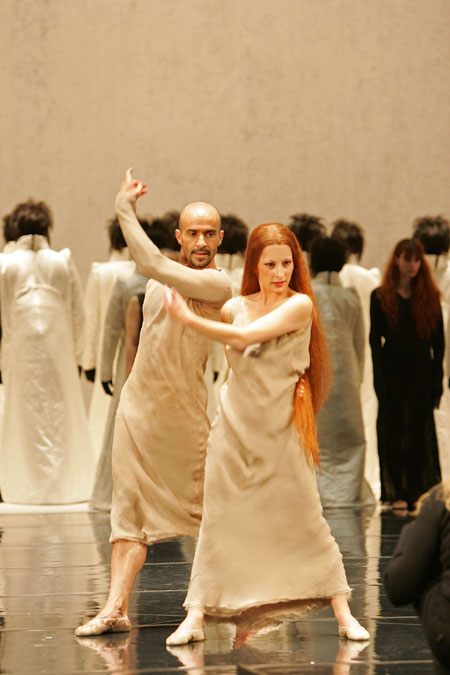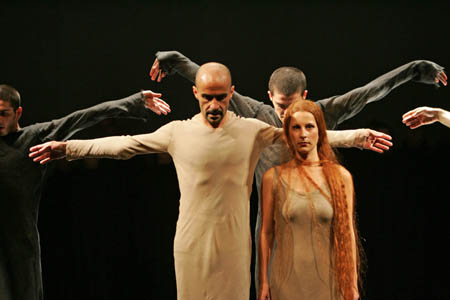|
Seen and
Heard Opera Review
GLUCK, Orpheo et Eurydice,
Soloists, Opera North and Emio Greco/PC, Lowry Theatre, Salford Quays,
October 23rd 2004 (RJF)
First seen at the Edinburgh Festival, Opera North’s Orpheo ed
Euridice reached the Lowry Theatre as part of the company’s
autumn tour which also featured two performances each of Puccini’s
Manon and Mozart’s Cosi Fan Tutte. When I write Opera North’s
Orpheo I may be starting with a significant error. This idiosyncratic
presentation of the opera arose out of the regular collaboration between
the Dutch based Emio Greco/PC (for Pieter C Scholten) internationally
renowned modern dance company and the Edinburgh Festival. EG/PC wished
to create and present the opera in their vision. For this they needed
a collaborator. At the pre-performance talk it was said that five
U.K. opera companies had been considered and Opera North chosen. Certainly
Opera North has a reputation for unusual productions as illustrated
by their Eight Little Greats Series of summer 2004. But then the same
could be said of the other U.K. regional companies if Scottish Opera’s
Aida or Welsh National Opera’s Die Fledermaus are anything to
go by. I do remember an evening at Opera North when a modern dance
version of Tchaikovsky’s The Nutcracker was presented alongside
the composer’s one act opera Yolanta. On that occasion the two
were distinctly separate entities. Here the aim was total integration
of the opera and the dance to give a cohesive whole.

Perhaps the fact that the direction, stage design and choreography
were by EG/PC weighed the priorities. The stage was a bare three-sided
shoebox with plain sides. Bleak lighting and projected patterned images
onto the walls were used liberally; occasionally to good effect. There
were no sets. The music was the straight original version as performed
at the premier in 1762 when Gluck sought to break away from the static
conventions of tableau and aria with well integrated chorus and dance
forms as an integral complement to the singers in solo or duet. In
the first part of the work, which was given without break, the chorus
were dressed in something akin to floor length white tents topped
by stiff collars. Black wigs and gloves completed the deliberately
androgynous outfits. It was only possible to determine the male from
the female by the more naturally rounded, rather than padded, chests
of the latter. The chorus moved about the stage very slowly and often
with arm movements. They acted as the gates of Hades among other representations.
Emio Greco and his seven dancers moved in and around the chorus and
soloists, he as a shadowy twin of Amore sometimes mouthing her words
as she sang. The dancing was full of twitches, writhings and gyrations
that did little to illuminate my understanding of the evolving drama.
Maybe some of these ill co-ordinated violent twitchings and energetic
contortions were meant to illustrate Orfeo’s mental agony and
torment.
The conductor wished to represent the 1762 version as originally performed.
He asked the chorus to whiten their tone. The result was a lack of
the vibrancy regularly heard from this chorus. This was a significant
loss when Orfeo sought to enter Hades against the furies. Likewise
the singing of the soloists was largely without vibrato. Surely the
castrato Gaetano Guadagni, who created the role of Orpheo, and who
started as a contralto before raising his voice to soprano would have
invested more colour into his singing. As it was the Canadian countertenor
Daniel Taylor was thin of tone and whilst being strong at the top
of his voice the lower was largely absent. In consequence the great
aria of the opera ‘Che faro’ went for nothing. The Spanish
lyric soprano Isabel Monar as Euridice looked lovely. Her singing
was accurate and well characterised. I do wonder, however, why Opera
North persist in importing singers for parts such as this when we
have an indigenous stock of under employed singers who could do just
a well. As Amore native born, and Manchester trained, Claire Ormshaw
provided some of the strongest singing of the evening, even when standing
on one leg and gesticulating her hands in parallel with Emio Greco’s.
Movements that also seemed wholly superfluous.

The orchestra under Nicholas Kok were well articulated. At the pre-performance
talk we were told that there were also some period instruments in
the pit although the orchestra were using their usual instruments
tuned to normal concert pitch.
The last time Orpheo ed Euridice played in Manchester, the audience
could clearly differentiate the entrance to Hades from the Elysian
Fields where the ladies were draped in Grecian style dresses with
the odd naked breast on view. Certainly the effect was more comprehensible
and aesthetically pleasing than what was presented at this performance.
When an opera lover goes to see Orpheo ed Euridice they would normally
expect to see the dance sequences integrated into the production.
What was presented here was modern dance with the backing of an opera
company and solo principals. It was a good job that clear surtitles
were available so the audience could follow what was happening on
stage. The programme shows photographs by Pasqual Martini. Emio Greco
and Pieter C Scholten felt these images resonated with their own work
and added ‘a new dimension to the key notations that are at
the root of their development of the Orfeo material’. Some of
these photographs involve images of dead and dying animals and people.
It perhaps says it all. Perhaps Opera North were not so much chosen
but chose the short straw.
Robert J Farr
Photos: Orfeo ed Eurydice, Opera North
© Bill Cooper
Back to the Top
Back
to the Index Page
|

